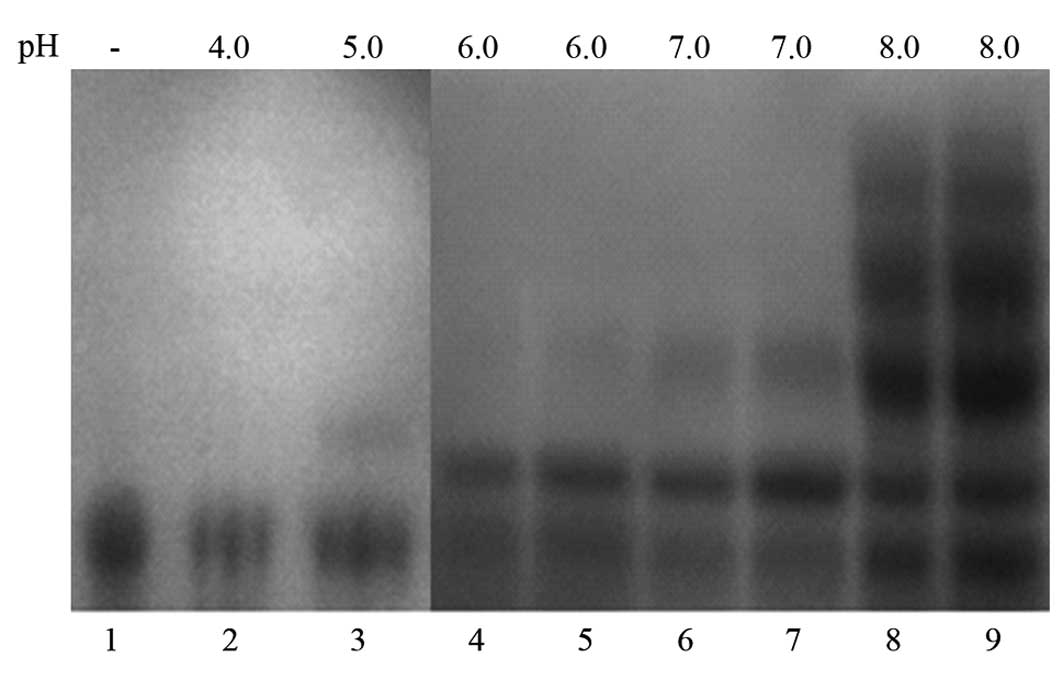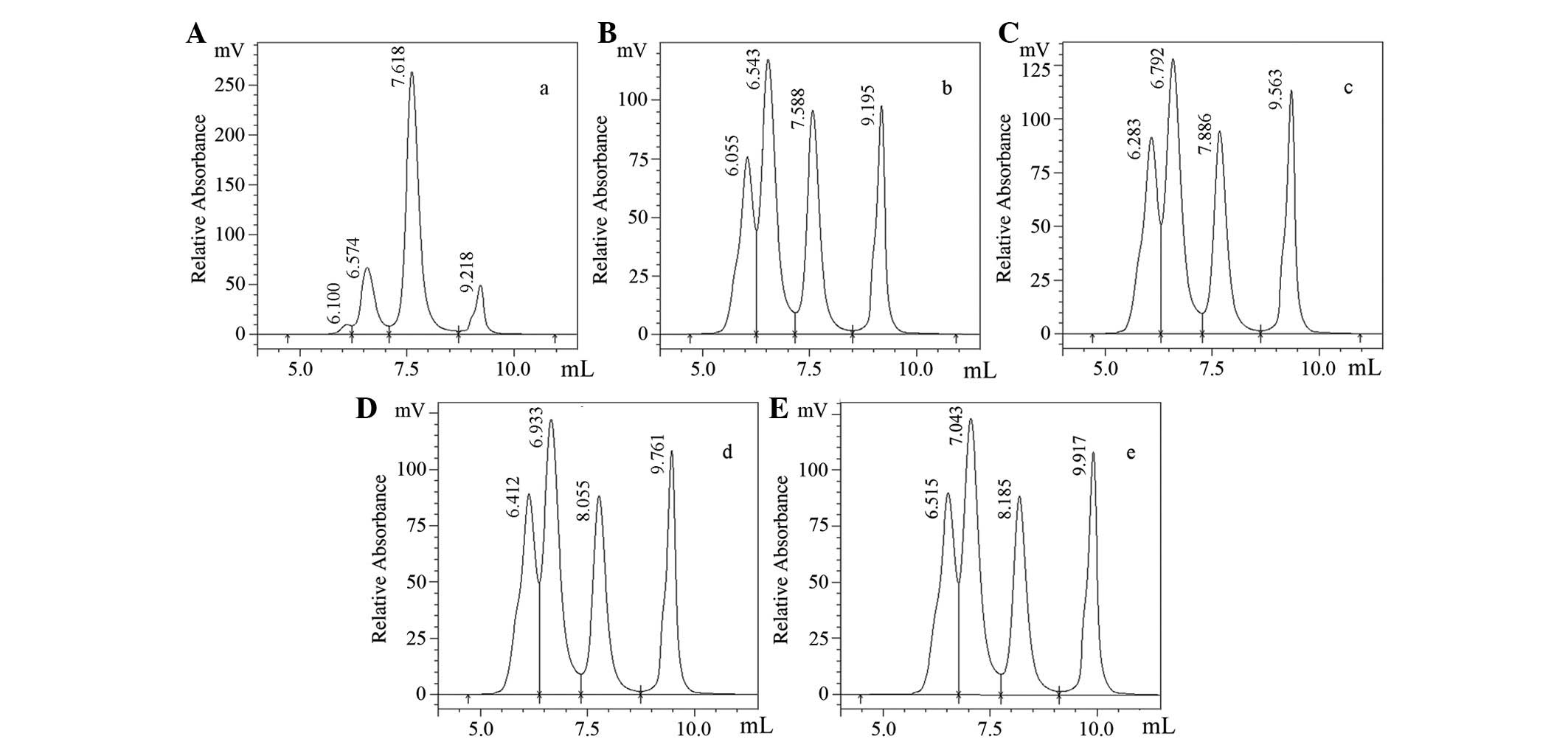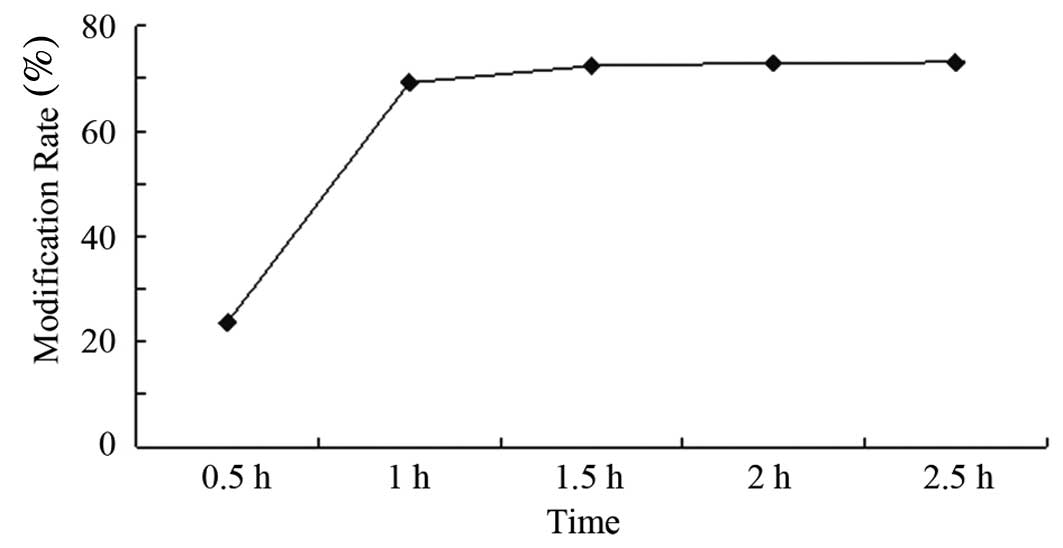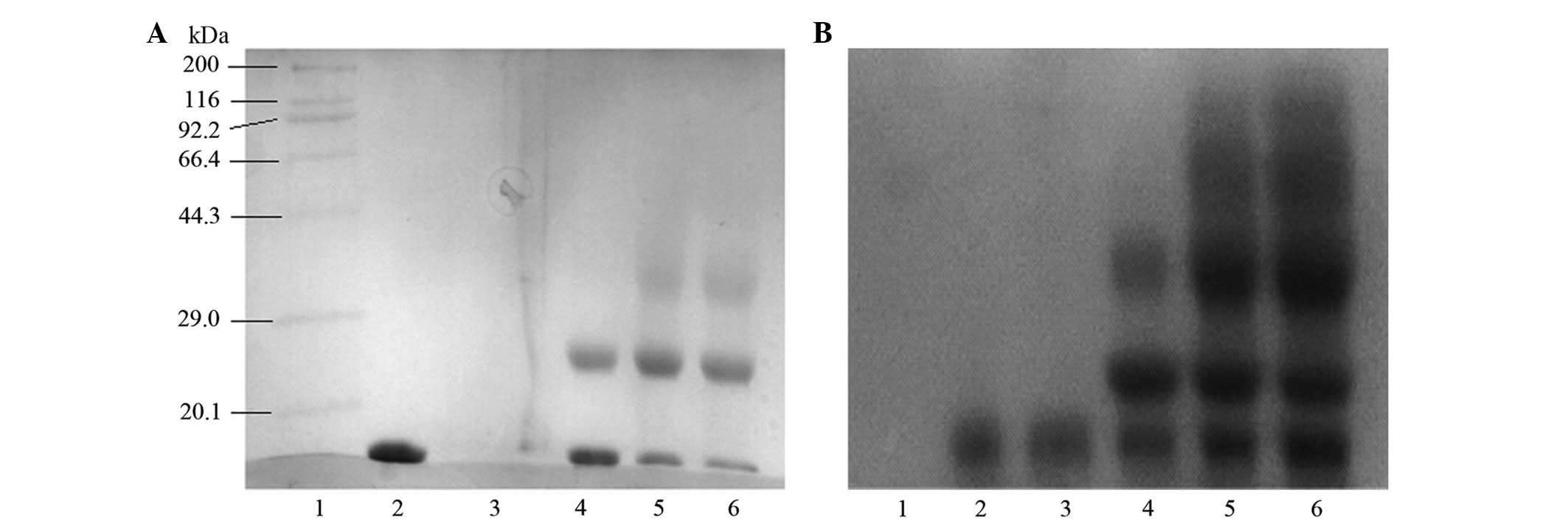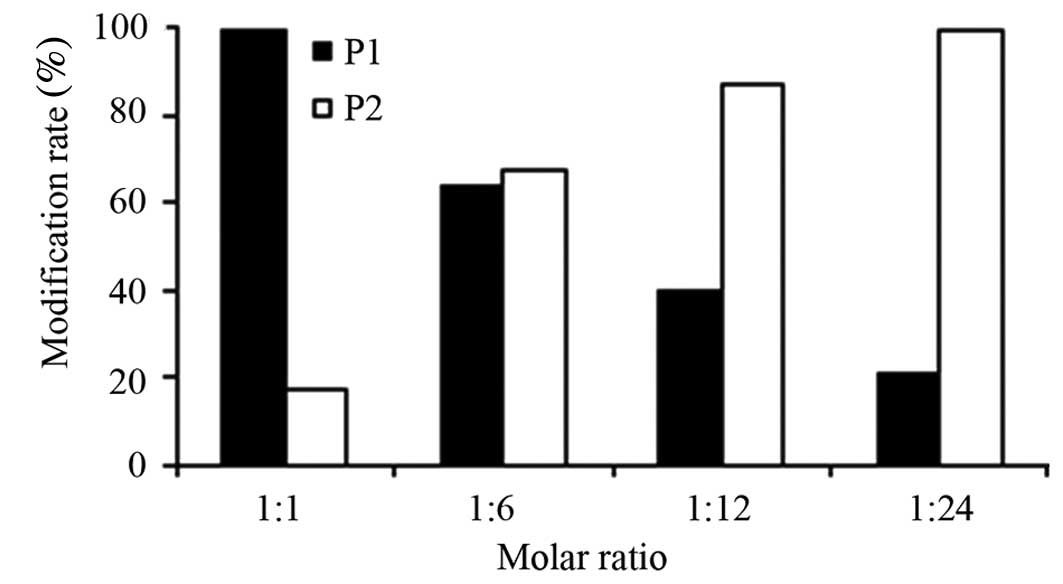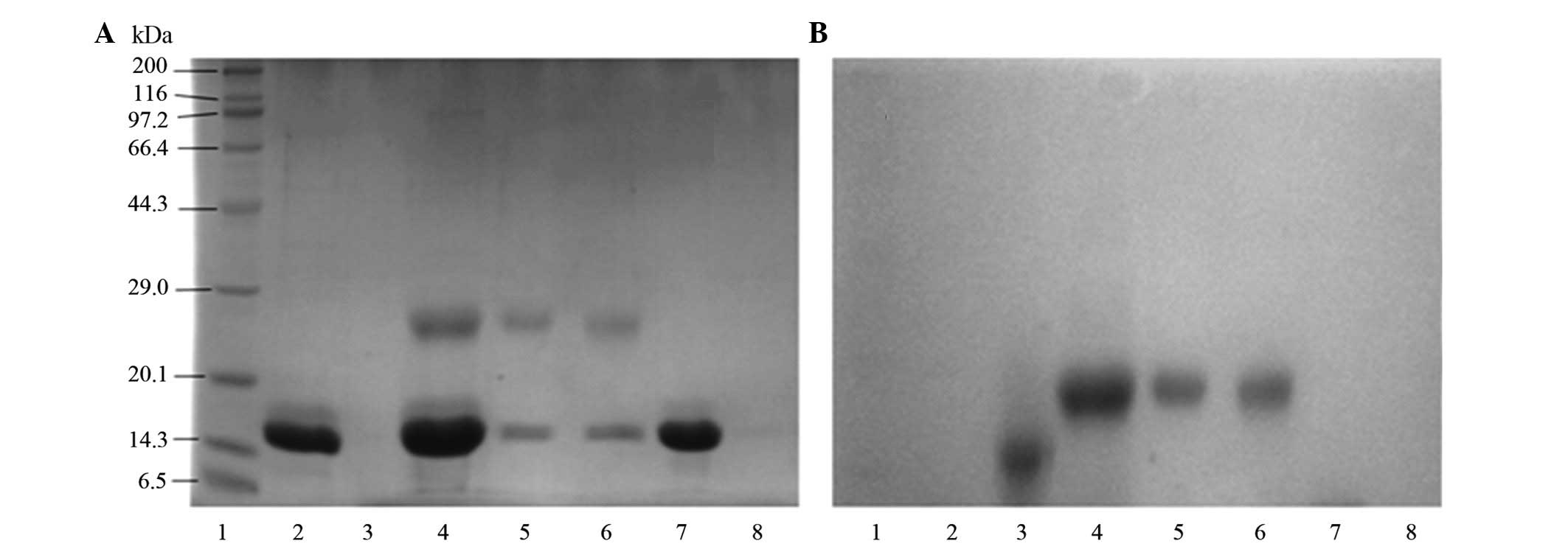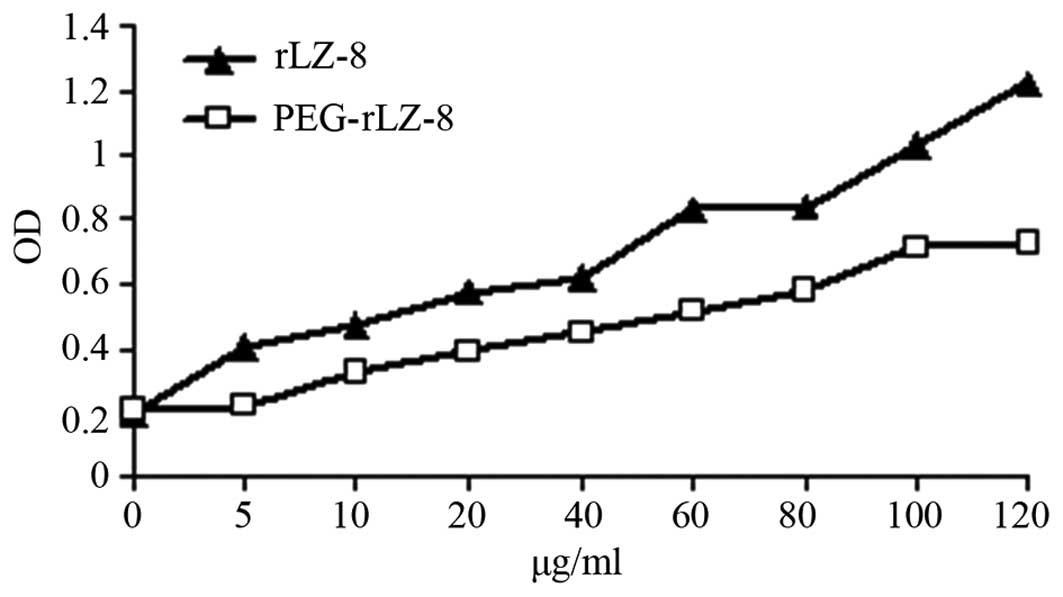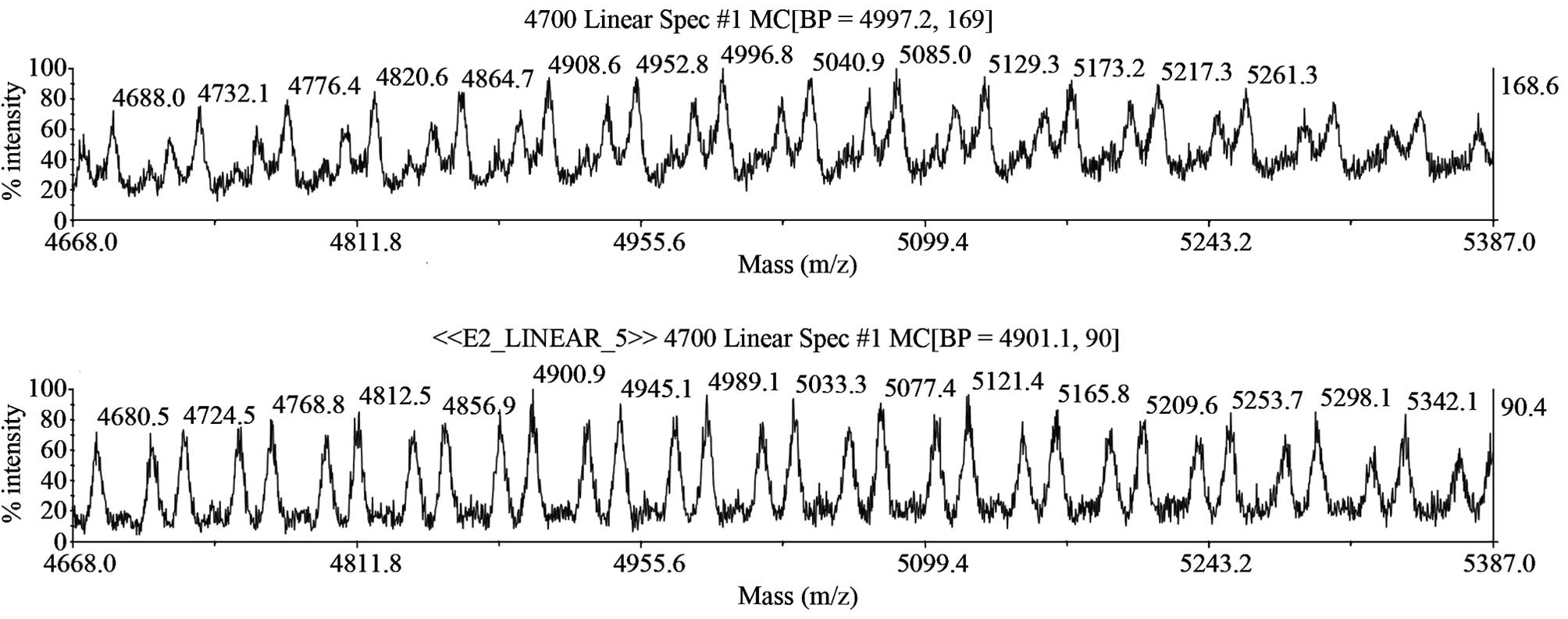Recombinant Ganoderma lucidum immunomodulatory protein modified with polyethylene glycol
- Authors:
- Published online on: January 18, 2013 https://doi.org/10.3892/mmr.2013.1281
- Pages: 975-980
Abstract
Introduction
Recombinant Ganoderma lucidum immunomodulatory protein (rLZ-8), expressed using a Pichia yeast eukaryotic expression system (1–3), was the first member of the fungal immunomodulatory protein (FIP) family discovered in mushrooms. It has been shown that rLZ-8 enjoys a promising prospect as a new class I drug, since it induces apoptosis in K562 and HL60 cells and acts as an immunomodulating protein in a variety diseases, including in the non-obese diabetes mouse model and in immunomodulation of food-induced allergic reactions (4–14). However, rLZ-8 has a MW of only 13 kDa and its dynamic properties, such as the half-life, are not satisfactory, which enormously limits its clinical application (15–19).
In this study, we explored a strategy to overcome the natural shortcomings of rLZ-8 using conventional PEGylation technology to prolong its half-life and to enhance its stability (20–27). We optimized the modification and purification process, successfully prepared the single-point modification product and carried out an initial characterization of the association between the modification sites and the activity of the modified product. This study has provided insights into the structure-activity relationship of rLZ-8 and has also laid a foundation for the development of long-acting formulations of rLZ-8.
Materials and methods
Instruments and reagents
The following instruments/instrument systems were used in this study: HPLC System (Shimadzu, Japan); AKTA Explorer 100 protein purification workstation (GE Healthcare, Franklin Lakes, NJ, USA); ultrafiltration cup (GE Healthcare); gel imager (Tanon, Shanghai, China); SDS-PAGE electrophoresis system (GE Healthcare); electrospray ionization source high-resolution tandem mass spectrometer (ESI-Q/TOF, Applied Biosciences, Carlsbad, CA, USA) and laser desorption time-of-flight mass spectrometry (MALDI-TOF/TOF, Applied Biosciences); Hiload 16/70 Superdex™ 75 gel column (GE Healthcare). Methoxy-PEG-succinimidyl propionate mPEG-SPA (5 kDa) was purchased from YareBio (Shanghai, China), and the recombinant Ganoderma lucidum immunomodulatory protein (rLZ-8) was obtained from our laboratory.
Modification optimization
Method
Optimization of the output of the single-point modification reaction was carried out by altering one single effect factor and keeping other factors the same in multi-level repeated trials. The effect of each factor on the conformation of reaction products was analyzed using SDS-PAGE and high-performance liquid chromatography (HPLC).
Effect of pH and ionic strength
The modification of rLZ-8 with mPEG-SPA (1:12, mol:mol) was carried out in a series of buffer systems at varying pH, namely pH 4.0, 5.0, 6.0, 7.0 or 8.0, and then in pH 8.0 phosphate buffer with varying ionic strengths, at 0.025, 0.05, 0.1 or 0.2 M, at room temperature for 2 h, away from light. The results were analyzed by SDS-PAGE followed by gel imaging after staining with barium iodide and Coomassie Brilliant Blue.
Effect of reaction time and temperature
In order to address the effect of time and temperature on the modification reaction, rLZ-8 and mPEG-SPA (1:12, mol:mol) were incubated together in a phosphate buffer system (0.1 M, pH 8.0) at 4, 16, 25 and 37°C, and sampled every 0.5 h for analysis by HPLC, up to 2.5 h.
Effect of molar ratio of rLZ-8 and mPEG-SPA
rLZ-8 and mPEG-SPA in a phosphate buffer system (0.1 M, pH 8.0) at molar ratios of 1:1, 1:3, 1:6, 1:12 and 1:24, were mixed at room temperature for 2 h, away from light. HPLC and SDS-PAGE with barium iodide or Coomassie Brilliant Blue staining were used to monitor the reaction products.
Purification and identification of the desired target product
The target product was purified using a Hiload 16/70 Superdex 75 gel chromatographic column with 0.05 M phosphate buffer containing 0.15 M NaCl (pH 7.0) and a flow rate of 1 ml/min. After equilibrating the column with the phosphate buffer for 2 column volumes (120 ml), iso-concentration elution was applied for another 1.5 column volumes, with peak collection at every 2 ml and detection wavelengths of 280, 254 and 215 nm. Every peak was detected using SDS-PAGE and HPLC and the retention times of the confirmed peaks were recorded.
Measurement of the biological activity of the target product
A lymphocyte transformation test (BrdU reagent box) was performed according to the manufacturer's instructions in order to determine the biological activity of rLZ-8 and mPEG-SPA-rLZ-8. The lymphocyte transformation test is based on the fact that lymphocytes stimulated by certain antigens transform and proliferate when re-exposed to the same antigens. The biological activity of antigens is measured by monitoring the proliferation of stimulated cells, and by measuring the incorporation of BrdU into replicating DNA. A chromophore coupled to an anti-BrdU antibody enables spectrophotometric detection of proliferating cells.
Analysis of the initial characteristics of the target product Detection of protein content
We used the Lowry method to measure the protein concentration of the reaction product according to the guidelines of the Chinese Pharmacopoeia 2010 Appendix VIB.
Validation of molecular weight and modification site
Firstly, the sample (in the form of dry powder) was placed into 50 mM NH4HCO to prepare a 1 mg/ml sample solution. A 20-μl aliquot of the sample solution was then diluted to obtain a 10-mM solution by adding 100 mM dithiothreitol (DTT) and heating at 56°C for 1 h. After cooling the mixture to room temperature, 250 mM indole-3-acetic acid (IAA) was added to obtain a 25-mM sample solution and this mixture was protected from light for 1 h. After completion of this step, 0.5 μg Trypsin was added and the sample was digested at 37°C for 12 h. Finally, the reaction was ended by adding 1 μl of 10% trifluoroacetic acid (TFA). The digestion products and matrix were mixed at a proportion of 1:3 and dried atmospherically. The peptide mass was detected by PMF analysis in order to identify the PEGylated site on rLZ-8 in the following modes: the mass spectra for the 500–4000 m/z range were determined in the reflection positive ion mode and the 1000–10000 m/z range was determined in the linear positive ion mode.
Results
Modification optimization
Effect of pH and ionic strength
The results of SDS-PAGE analysis of the PEGylation reaction mixture following barium iodide staining are shown in Fig. 1. As the figure indicates, no modification reaction (indicated by the appearance of higher-MW bands) occurred until pH 5.0, and a weak reaction occurred between pH 5.0 and 7.0. When the pH was >8, the reaction was more efficient and numerous modification products were detected. By contrast, variation of ionic strength hardly affected the modification reaction. Therefore, we chose pH 8.0 as the reaction pH in further studies.
Effect of reaction time and temperature
The reaction products were single and relatively unstable at 0.5 h, which indicates the reaction was still in progress (Fig. 2A). Between 1 and 2.5 h, the reaction results appeared to be similar (as shown in Fig. 2B-E) and the reaction products did not change significantly (Fig. 3), indicating that the reaction had reached equilibrium after 1 h. Additionally, the experiment was undertaken at room temperature, since temperature did not have a significant effect on the reaction products (data not shown). As a result, we chose room temperature and 2 h as the reaction conditions.
Effect of molar ratio of rLZ-8 and mPEG-SPA
Fig. 4 illustrates how the molar ratios of rLZ-8 to mPEG-SPA influenced the modification reaction. The modification products became increasingly varied (as indicated by the less discrete appearance of the higher-MW bands) when the molar ratio of rLZ-8 to mPEG-SPA was decreased. Only one type of modification product occurred at the molar ratio of 1:1, so each modification product occupies 100% of the product, with the exception of the remaining unmodified rLZ-8. When the molar ratio was 1:24, there were four modification products and each one contributed to 18.57% of the total mixture (Figs. 4 and 5). For ease of purification, a molar ratio of 1:1 was chosen for single-point modification.
Purification and identification of the target product
As shown in Fig. 6A and Fig. 7, only one type of modification product occurred at a molar ratio of 1:1. According to the molecular sieve principle, the purity of the purification product may reach 99% after being purified using a Superdex 75 gel chromatographic column, a result that we also observed when using this chromatographic purification method (Fig. 6B).
Biological activity of the purified target product
The biological activities of rLZ-8 and PEG-rLZ-8 (as assessed using a BrdU incorporation assay) are shown in Fig. 8. When modified by PEG, the activity of the modification products of rLZ-8 decreased as expected.
Preliminary analysis of the characteristics of target products
Detection of protein content
The Lowry method was used to determine the concentration of protein in the modification product due to its outstanding linear correlation, both before and after modification. The amount of rLZ-8 decreased from 5 to 0.96 mg following the modification and purification process.
Validation of molecular weight and modification site
Several points were considered in order to correctly identify the modification site. Firstly, the PEG-peptide may not match the expected peptide mass fingerprint (PMF) and those that match usually represent unPEGylated peptides in the modification sample. Secondly, the PEGylated site is always located at the N-terminus or on a Lys side chain. Thirdly, PEGylated Lys is usually intractable to enzymatic cleavage, in which case, when Lys is modified at least one uncleaved site is always included, and the margin between the PEG-peptide and PEG should be close to the theoretical MW of the peptide, while the MS/MS peak shape of the PEG-peptide should be consistent with that of PEG.
From the data, we conclude that Lys is not the PEGylated site, as all Lys in the PEG-protein matched the PMF and the molecular weight of the PEG-peptides were close to that of PEG. Therefore, we concluded that the PEGylated site did not fall within the 75–111 amino acid fragment of rLZ-8 (this fragment is 4205.9858 Da). In the determination of the PMF of the PEG-protein, N-terminal peptides with and without the M fragment (SDTALIFR) were observed, so the PEGylated site is estimated to be at the N-terminus, as the falling off of M in the process is not expected to affect the correspondence in MW between the peptides and the PMF (Fig. 9). Furthermore, the margin of the MW between PEG-peptides and PEG are relatively close to M, which provides further evidence that the PEGylated site is located at the N-terminus.
Discussion
In this study, we established a strategy for modifying rLZ-8 using mPEG-SPA and evaluated the effect of various reaction parameters on the modification reaction. The pH of the reaction buffer was the determining factor in the modification reaction, and the modification reaction could not be carried out under acidic conditions. The desired reaction products were recovered in pH 8.0 phosphate buffer solution; however, the molar ratio of rLZ-8 to mPEG-SPA was also an important factor affecting the reaction products. A molar ratio of 1:1 yielded a single-site modification product, and the composition of the reaction products became more and more complex as the amount of mPEG-SPA was increased. When the molar ratio was >1:12, there were four species of products, of ~66, 44, 30 and 17.9 kDa. The reaction temperature had almost no effect on the modification reaction, and the reaction reached equilibrium after 1 h. From these data, we concluded that the best conditions to obtain a single-site modified product are: 0.05 M, pH 8.0 phosphate buffer solution, a 1:1 molar ratio of rLZ to mPEG-SPA, and stirring at room temperature for 2 h, protected from light.
PEG modification sites are generally at the N-terminus or on Lys side chains. The structural analysis of rLZ-8 (17) revealed that the active form of rLZ-8 is a non-covalently bonded dimer and that each monomer contains 6 Lys. Therefore, in theory, one rLZ-8 molecule may combine with 1–7 mPEG-SPA molecules, but the mPEG can only modify the N-terminus of the protein. Since mPEG-SPA has long-chain branches and is sticky, the greater the amount of mPEG-SPA that combines with the protein, the greater the reduction in activity, and the more complex the product composition is likely to be. In this study, we focused on optimizing reaction conditions to obtain a single-site modified product.
The MW of the single-site modified product is ~17.9 kDa, so we selected the Superdex 75 separation column to purify the modification reaction mixture. Purification results revealed that the modified products can be separated completely from the unreacted rLZ-8 and that the small molecule byproducts can be removed. Moreover, the single-site modified products were of high purity and the excess rLZ-8 could be recycled and reused in the experiment. Separation and purification of a variety of modified products in excess of mPEG-SPA is more difficult, and further studies are required to optimize recovery of other modification products.
An in vitro assay for assessing the biological activity of the single-site modified product indicated that mPEG-SPA altered the efficacy of the protein in a lymphocyte transformation assay. Additional in vivo experiments should be carried out to determine the pharmacokinetic properties, such as the half-life and effective dose, of the modified rLZ-8. Such detailed analysis is likely to facilitate the clinical application of modified products such as PEGylated rLZ-8.
Acknowledgements
This study was supported by the Science and Technology Development Program of Jilin Province (Grant No. 20090941).
References
|
Liang C, Zhang S, Liu Z and Sun F: Ganoderma lucidum immunomodulatory protein(Lz-8) expressed in Pichia pastoris and the identification of immunocompetence. Sheng Wu Gong Cheng Xue Bao. 25:441–447. 2009. | |
|
Lin JW, Hao LX, Xu GX, Sun F, Gao F, Zhang R and Liu LX: Molecular cloning and recombinant expression of a gene encoding a fungal immunomodulatory protein from Ganoderma lucidum in Pichia pastoris. World J Microbiol Biotechnol. 25:383–390. 2009. View Article : Google Scholar | |
|
Murasugi A, Tanaka S, Komiyama N, Iwata N, Kino K, Tsunoo H and Sakuma S: Molecular cloning of a cDNA and a gene encoding an immunomodulatory protein, Ling Zhi-8, from a fungus, Ganoderma lucidum. J Biol Chem. 266:2486–2493. 1991.PubMed/NCBI | |
|
Wang XL, Liang CY, Li HR, Li BZ and Sun F: Recombinant Ganoderma lucidum immunoregulatory protein (rLZ-8) induces nuclear-stress apoptosis in K562 cells. Zhongguo Mian Yi Xue Za Zhi. 26:616–618. 2010.(In Chinese). | |
|
Guo Q, Sun H, Liang CY, Zhang SQ, Liu ZY and Sun F: Inhibiting and apoptosis-inducing effects of recombinant Ganoderma lucidum immunoregulatory protein on HL60 cells. Zhongguo Mian Yi Xue Za Zhi. 26:520–522. 2010.(In Chinese). | |
|
Liang CY, Zhang SQ and Sun F: The dynamic observation: cellular localization of fluorescein isothiocyanate labeled recombinant Ganoderma lucidum immunoregulatory protein (rLZ-8) in NB4 APL cell. Chemical Journal of Chinese Universities: CJCU. 30:479–483. 2009. | |
|
Kino K, Mizumoto K, Sone T, Yamaji T, Watanabe J, Yamashita A, Yamaoka K, Shimizu K, Ko K and Tsunoo H: An immunomodulating protein, Ling Zhi-8 (LZ-8) prevents insulitis in non-obese diabetic mice. Diabetologia. 33:713–718. 1990. View Article : Google Scholar : PubMed/NCBI | |
|
Haak-Frendscho M, Kino K, Sone T and Jardieu P: Ling Zhi-8: a novel T cell mitogen induces cytokine production and upregulation of ICAM-1 expression. Cell Immunol. 150:101–113. 1993. View Article : Google Scholar : PubMed/NCBI | |
|
Hsieh KY, Hsu CI, Lin JY, Tsai CC and Lin RH: Oral administration of an edible-mushroom-derived protein inhibits the development of food-allergic reactions in mice. Clin Exp Allergy. 33:1595–1602. 2003. View Article : Google Scholar : PubMed/NCBI | |
|
Liu YH, Kao MC, Lai YL and Tsai JJ: Efficacy of local nasal immunotherapy for 10. Dp2-induced airway inflammation in mice: using Dp2 peptide and fungal immunomodulatory peptide. J Allergy Clin Immunol. 112:301–310. 2003. View Article : Google Scholar : PubMed/NCBI | |
|
Ho JC, Sze SC, Shen WZ and Liu WK: Mitogenic antivity of edible mushroom lectins. Biochim Biophys Acta. 1671:9–17. 2004. View Article : Google Scholar : PubMed/NCBI | |
|
Wasser SP and Weis AL: Therapeutic effects of substances occurring in higher Basidiomycetes mushrooms: a modern perspective. Crit Rev Immunol. 19:65–96. 1999.PubMed/NCBI | |
|
Llovet JM and Bruix J: Systematic review of randomized trials for unresectable hepatocellular carcinoma: chemoembolization improves survival. Hepatology. 37:429–442. 2003. View Article : Google Scholar | |
|
Liang CY, Li H, Zhou H, Zhang SQ, Liu ZY, Zhou Q and Sun F: Recombinant Lz-8 from Ganoderma lucidum induces endoplasmic reticulum stress-mediated autophagic cell death in SGC-7901 human gastric cancer cells. Oncol Rep. 27:1079–1089. 2012. | |
|
van der Hem LG, van der Vliet JA, Bocken CF, Kino K, Hoitsma AJ and Tax WJ: Ling Zhi-8: studies of a new immunomodulating agent. Transplantation. 60:438–443. 1995.PubMed/NCBI | |
|
Zhu JQ, Liang CY, Feng K, Gai XD, Sun X and Sun F: Purification and properties of recombinant Ganoderma lucidum immunoregulatory protein. Chem Res Chin Univ. 29:1–4. 2008. | |
|
Huang L, Sun F, Liang CY, He YX, Bao R, Liu L and Zhou CZ: Crystal structure of LZ-8 from the medicinal fungus Ganoderma lucidium. Proteins. 75:524–527. 2009. View Article : Google Scholar : PubMed/NCBI | |
|
Lin WH, Hung CH, Hsu CI and Lin JY: Dimerisation of the N-terminal amphipathic α-helix domain of the fungal immunomodulatory protein from Ganoderma tsugae (Fip-gts) defined by a yeast two-hybrid system and site-directed mutagenesis. J Biol Chem. 272:20044–20048. 1997.PubMed/NCBI | |
|
Tanaka S, Ko K, Kino K, Tsuchiya K, Yamashita A, Murasugi A, Sakuma S and Tsunoo H: Complete amino acid sequence of an immunomodulatory protein, ling zhi-8 (LZ-8). An immunomodulator from a fungus, Ganoderma lucidium, having similarity to immunoglobulin variable regions. J Biol Chem. 264:16372–16377. 1989.PubMed/NCBI | |
|
Roberts MJ, Bentley MD and Harris JM: Chemistry for peptide and protein PEGylation. Adv Drug Deliv Rev. 54:459–476. 2002. View Article : Google Scholar : PubMed/NCBI | |
|
Fee CJ and Van Alstine JM: PEG-proteins: Reaction engineering and separation issues. Chem Eng Sci. 61:924–939. 2005. | |
|
Kinstler O, Molineux G, Treuheit M, Ladd D and Gegg C: Mono-N-terminal poly(ethylene glycol)-protein conjugates. Adv Drug Deliv Rev. 54:477–485. 2002. View Article : Google Scholar : PubMed/NCBI | |
|
Greenwald RB: PEG drugs: an overview. J Control Release. 74:159–171. 2001. View Article : Google Scholar : PubMed/NCBI | |
|
Seyfried BK, Siekmann J, Belgacem O, Wenzel RJ, Turecek PL and Allmaier G: MALDI linear TOF mass spectrometry of PEGylated (glyco)proteins. J Mass Spectrom. 45:612–617. 2010.PubMed/NCBI | |
|
Ronda L, Pioselli B, Bruno S, Faggiano S and Mozzarelli A: Electrophoretic analysis of PEGylated hemoglobin-based blood substitutes. Anal Biochem. 408:118–123. 2011. View Article : Google Scholar : PubMed/NCBI | |
|
Zhai Y, Zhao Y, Lei J, Su Z and Ma G: Enhanced circulation half-life of site-specific PEGylated rhG-CSF: optimization of PEG molecular weight. J Biotechnol. 142:259–266. 2009. View Article : Google Scholar : PubMed/NCBI | |
|
Moosmann A, Christel J, Boettinger H and Mueller E: Analytical and preparative separation of PEGylated lysozyme for the characterization of chromatography media. J Chromatogr A. 1217:209–215. 2010. View Article : Google Scholar : PubMed/NCBI |



